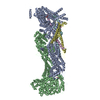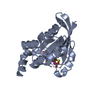+ Open data
Open data
- Basic information
Basic information
| Entry | Database: PDB / ID: 7usd | ||||||
|---|---|---|---|---|---|---|---|
| Title | Cryo-EM structure of D-site Rac1-bound WAVE Regulatory Complex | ||||||
 Components Components |
| ||||||
 Keywords Keywords | CELL INVASION / actin regulator / GTPase binding protein / cytoskeletal regulator | ||||||
| Function / homology |  Function and homology information Function and homology informationzygotic determination of anterior/posterior axis, embryo / dendritic transport of mitochondrion / SCAR complex / notochord morphogenesis / mesodermal cell migration / positive regulation of neurotrophin TRK receptor signaling pathway / lamellipodium morphogenesis / basal protein localization / paraxial mesoderm morphogenesis / positive regulation of Arp2/3 complex-mediated actin nucleation ...zygotic determination of anterior/posterior axis, embryo / dendritic transport of mitochondrion / SCAR complex / notochord morphogenesis / mesodermal cell migration / positive regulation of neurotrophin TRK receptor signaling pathway / lamellipodium morphogenesis / basal protein localization / paraxial mesoderm morphogenesis / positive regulation of Arp2/3 complex-mediated actin nucleation / embryonic body morphogenesis / establishment or maintenance of actin cytoskeleton polarity / cell migration involved in gastrulation / Arp2/3 complex binding / regulation of actin polymerization or depolymerization / embryonic olfactory bulb interneuron precursor migration / anatomical structure arrangement / regulation of ERK5 cascade / angiotensin-activated signaling pathway involved in heart process / positive regulation of ovarian follicle development / cerebral cortex GABAergic interneuron development / regulation of respiratory burst / dendrite extension / auditory receptor cell morphogenesis / cerebral cortex radially oriented cell migration / modification of postsynaptic actin cytoskeleton / erythrocyte enucleation / regulation of neutrophil migration / negative regulation of interleukin-23 production / localization within membrane / regulation of translation at postsynapse, modulating synaptic transmission / Activated NTRK2 signals through CDK5 / regulation of hydrogen peroxide metabolic process / interneuron migration / kinocilium / regulation of cell adhesion involved in heart morphogenesis / negative regulation of receptor-mediated endocytosis / engulfment of apoptotic cell / ruffle assembly / NTRK2 activates RAC1 / NADPH oxidase complex / Inactivation of CDC42 and RAC1 / cochlea morphogenesis / embryonic foregut morphogenesis / regulation of neuron maturation / regulation of actin filament polymerization / respiratory burst / WNT5:FZD7-mediated leishmania damping / cortical cytoskeleton organization / SEMA3A-Plexin repulsion signaling by inhibiting Integrin adhesion / positive regulation of skeletal muscle acetylcholine-gated channel clustering / regulation of modification of postsynaptic actin cytoskeleton / hepatocyte growth factor receptor signaling pathway / GTP-dependent protein binding / endoderm development / RNA 7-methylguanosine cap binding / midbrain dopaminergic neuron differentiation / ruffle organization / epithelial cell morphogenesis / cell projection assembly / positive regulation of bicellular tight junction assembly / regulation of lamellipodium assembly / thioesterase binding / regulation of stress fiber assembly / regulation of neuron migration / negative regulation of fibroblast migration / RHO GTPases activate CIT / cell-cell junction organization / sphingosine-1-phosphate receptor signaling pathway / embryonic heart tube development / Nef and signal transduction / motor neuron axon guidance / PCP/CE pathway / RHO GTPases activate KTN1 / Activation of RAC1 / apical protein localization / axon extension / MET activates RAP1 and RAC1 / positive regulation of neutrophil chemotaxis / regulation of nitric oxide biosynthetic process / DCC mediated attractive signaling / Azathioprine ADME / Sema4D mediated inhibition of cell attachment and migration / hyperosmotic response / positive regulation of cell-substrate adhesion / Ephrin signaling / CD28 dependent Vav1 pathway / positive regulation of ruffle assembly / cortical actin cytoskeleton organization / superoxide anion generation / Wnt signaling pathway, planar cell polarity pathway / lamellipodium assembly / regulation of receptor signaling pathway via JAK-STAT / Activation of RAC1 downstream of NMDARs / small GTPase-mediated signal transduction / protein kinase A binding / NRAGE signals death through JNK / dendrite morphogenesis / regulation of cell size / Rho GDP-dissociation inhibitor binding Similarity search - Function | ||||||
| Biological species |  Homo sapiens (human) Homo sapiens (human) | ||||||
| Method | ELECTRON MICROSCOPY / single particle reconstruction / cryo EM / Resolution: 3 Å | ||||||
 Authors Authors | Ding, B. / Yang, S. / Chen, B. / Chowdhury, S. | ||||||
| Funding support |  United States, 1items United States, 1items
| ||||||
 Citation Citation |  Journal: Nat Commun / Year: 2022 Journal: Nat Commun / Year: 2022Title: Structures reveal a key mechanism of WAVE regulatory complex activation by Rac1 GTPase. Authors: Bojian Ding / Sheng Yang / Matthias Schaks / Yijun Liu / Abbigale J Brown / Klemens Rottner / Saikat Chowdhury / Baoyu Chen /    Abstract: The Rho-family GTPase Rac1 activates the WAVE regulatory complex (WRC) to drive Arp2/3 complex-mediated actin polymerization in many essential processes. Rac1 binds to WRC at two distinct sites-the ...The Rho-family GTPase Rac1 activates the WAVE regulatory complex (WRC) to drive Arp2/3 complex-mediated actin polymerization in many essential processes. Rac1 binds to WRC at two distinct sites-the A and D sites. Precisely how Rac1 binds and how the binding triggers WRC activation remain unknown. Here we report WRC structures by itself, and when bound to single or double Rac1 molecules, at ~3 Å resolutions by cryogenic-electron microscopy. The structures reveal that Rac1 binds to the two sites by distinct mechanisms, and binding to the A site, but not the D site, drives WRC activation. Activation involves a series of unique conformational changes leading to the release of sequestered WCA (WH2-central-acidic) polypeptide, which stimulates the Arp2/3 complex to polymerize actin. Together with biochemical and cellular analyses, the structures provide a novel mechanistic understanding of how the Rac1-WRC-Arp2/3-actin signaling axis is regulated in diverse biological processes and diseases. | ||||||
| History |
|
- Structure visualization
Structure visualization
| Structure viewer | Molecule:  Molmil Molmil Jmol/JSmol Jmol/JSmol |
|---|
- Downloads & links
Downloads & links
- Download
Download
| PDBx/mmCIF format |  7usd.cif.gz 7usd.cif.gz | 524 KB | Display |  PDBx/mmCIF format PDBx/mmCIF format |
|---|---|---|---|---|
| PDB format |  pdb7usd.ent.gz pdb7usd.ent.gz | 417.2 KB | Display |  PDB format PDB format |
| PDBx/mmJSON format |  7usd.json.gz 7usd.json.gz | Tree view |  PDBx/mmJSON format PDBx/mmJSON format | |
| Others |  Other downloads Other downloads |
-Validation report
| Summary document |  7usd_validation.pdf.gz 7usd_validation.pdf.gz | 1.4 MB | Display |  wwPDB validaton report wwPDB validaton report |
|---|---|---|---|---|
| Full document |  7usd_full_validation.pdf.gz 7usd_full_validation.pdf.gz | 1.4 MB | Display | |
| Data in XML |  7usd_validation.xml.gz 7usd_validation.xml.gz | 82.1 KB | Display | |
| Data in CIF |  7usd_validation.cif.gz 7usd_validation.cif.gz | 124.9 KB | Display | |
| Arichive directory |  https://data.pdbj.org/pub/pdb/validation_reports/us/7usd https://data.pdbj.org/pub/pdb/validation_reports/us/7usd ftp://data.pdbj.org/pub/pdb/validation_reports/us/7usd ftp://data.pdbj.org/pub/pdb/validation_reports/us/7usd | HTTPS FTP |
-Related structure data
| Related structure data |  26733MC 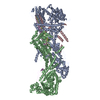 7uscC  7useC M: map data used to model this data C: citing same article ( |
|---|---|
| Similar structure data | Similarity search - Function & homology  F&H Search F&H Search |
- Links
Links
- Assembly
Assembly
| Deposited unit | 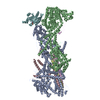
|
|---|---|
| 1 |
|
- Components
Components
-Protein , 6 types, 6 molecules ABCDEF
| #1: Protein | Mass: 145363.750 Da / Num. of mol.: 1 Source method: isolated from a genetically manipulated source Details: This construct contains two additional uncleaved residues "GA" in the N terminus from the construct design and purification procedure. Densities for these residues are not observed in the ...Details: This construct contains two additional uncleaved residues "GA" in the N terminus from the construct design and purification procedure. Densities for these residues are not observed in the map and were not included in the sample sequence to avoid numbering shifts. Source: (gene. exp.)  Homo sapiens (human) / Gene: CYFIP1, KIAA0068 / Production host: Homo sapiens (human) / Gene: CYFIP1, KIAA0068 / Production host:  Trichoplusia ni (cabbage looper) / References: UniProt: Q7L576 Trichoplusia ni (cabbage looper) / References: UniProt: Q7L576 |
|---|---|
| #2: Protein | Mass: 128940.727 Da / Num. of mol.: 1 Source method: isolated from a genetically manipulated source Details: This construct contains two additional uncleaved residues "GA" in the N terminus from the construct design and purification procedure. Densities for these residues are not observed in the ...Details: This construct contains two additional uncleaved residues "GA" in the N terminus from the construct design and purification procedure. Densities for these residues are not observed in the map and were not included in the sample sequence to avoid numbering shifts. Source: (gene. exp.)  Homo sapiens (human) / Gene: NCKAP1, HEM2, KIAA0587, NAP1 / Production host: Homo sapiens (human) / Gene: NCKAP1, HEM2, KIAA0587, NAP1 / Production host:  Trichoplusia ni (cabbage looper) / References: UniProt: Q9Y2A7 Trichoplusia ni (cabbage looper) / References: UniProt: Q9Y2A7 |
| #3: Protein | Mass: 37009.406 Da / Num. of mol.: 1 Source method: isolated from a genetically manipulated source Details: Residues 231-248 are inserted as a flexible linker sequence. This construct contains two additional uncleaved residues "GA" in the N terminus from the construct design and purification ...Details: Residues 231-248 are inserted as a flexible linker sequence. This construct contains two additional uncleaved residues "GA" in the N terminus from the construct design and purification procedure. Densities for these residues are not observed in the map and were not included in the sample sequence to avoid numbering shifts. Source: (gene. exp.)  Homo sapiens (human) / Gene: WASF1, KIAA0269, SCAR1, WAVE1 / Production host: Homo sapiens (human) / Gene: WASF1, KIAA0269, SCAR1, WAVE1 / Production host:  |
| #4: Protein | Mass: 8756.915 Da / Num. of mol.: 1 Source method: isolated from a genetically manipulated source Details: This construct contains uncleaved residues "GHMGAA" in the N terminus from the construct design and purification procedure. Densities for the residues are not observed in the map and were ...Details: This construct contains uncleaved residues "GHMGAA" in the N terminus from the construct design and purification procedure. Densities for the residues are not observed in the map and were not included in the sample sequence to avoid numbering shifts. Source: (gene. exp.)  Homo sapiens (human) / Gene: BRK1, C3orf10, HSPC300, MDS027 / Production host: Homo sapiens (human) / Gene: BRK1, C3orf10, HSPC300, MDS027 / Production host:  |
| #5: Protein | Mass: 18041.482 Da / Num. of mol.: 1 Source method: isolated from a genetically manipulated source Details: The sequence only contains residues 1-158. Also, there are two additional uncleaved residues "GH" in the N terminus from the construct design and purification procedure. Densities for these ...Details: The sequence only contains residues 1-158. Also, there are two additional uncleaved residues "GH" in the N terminus from the construct design and purification procedure. Densities for these residues are not observed in the map and were not included in the sample sequence to avoid numbering shifts. Source: (gene. exp.)  Homo sapiens (human) / Gene: ABI2 / Production host: Homo sapiens (human) / Gene: ABI2 / Production host:  |
| #6: Protein | Mass: 21010.486 Da / Num. of mol.: 1 / Mutation: P29S, Q61L Source method: isolated from a genetically manipulated source Source: (gene. exp.)  Homo sapiens (human) / Gene: RAC1, TC25, MIG5 / Production host: Homo sapiens (human) / Gene: RAC1, TC25, MIG5 / Production host:  Trichoplusia ni (cabbage looper) / References: UniProt: P63000, small monomeric GTPase Trichoplusia ni (cabbage looper) / References: UniProt: P63000, small monomeric GTPase |
-Non-polymers , 2 types, 2 molecules 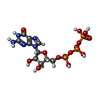


| #7: Chemical | ChemComp-GTP / |
|---|---|
| #8: Chemical | ChemComp-MG / |
-Details
| Has ligand of interest | Y |
|---|
-Experimental details
-Experiment
| Experiment | Method: ELECTRON MICROSCOPY |
|---|---|
| EM experiment | Aggregation state: PARTICLE / 3D reconstruction method: single particle reconstruction |
- Sample preparation
Sample preparation
| Component | Name: WAVE regulatory complex with Rac1 bound to D-site / Type: COMPLEX / Entity ID: #1-#6 / Source: MULTIPLE SOURCES | ||||||||||||
|---|---|---|---|---|---|---|---|---|---|---|---|---|---|
| Molecular weight | Value: 0.36 MDa / Experimental value: NO | ||||||||||||
| Source (natural) | Organism:  Homo sapiens (human) Homo sapiens (human) | ||||||||||||
| Source (recombinant) |
| ||||||||||||
| Buffer solution | pH: 7 | ||||||||||||
| Specimen | Conc.: 0.41 mg/ml / Embedding applied: NO / Shadowing applied: NO / Staining applied: NO / Vitrification applied: YES | ||||||||||||
| Specimen support | Details: 30 mA / Grid material: GOLD / Grid mesh size: 300 divisions/in. / Grid type: UltrAuFoil R1.2/1.3 | ||||||||||||
| Vitrification | Instrument: HOMEMADE PLUNGER / Cryogen name: ETHANE / Humidity: 95 % / Chamber temperature: 277.15 K |
- Electron microscopy imaging
Electron microscopy imaging
| Experimental equipment |  Model: Talos Arctica / Image courtesy: FEI Company |
|---|---|
| Microscopy | Model: FEI TALOS ARCTICA Details: Data were collected by shifting the stage to target exposure positions. |
| Electron gun | Electron source:  FIELD EMISSION GUN / Accelerating voltage: 200 kV / Illumination mode: FLOOD BEAM FIELD EMISSION GUN / Accelerating voltage: 200 kV / Illumination mode: FLOOD BEAM |
| Electron lens | Mode: BRIGHT FIELD / Nominal magnification: 120000 X / Nominal defocus max: 1000 nm / Nominal defocus min: 500 nm / Cs: 2.7 mm / C2 aperture diameter: 50 µm / Alignment procedure: BASIC |
| Specimen holder | Cryogen: NITROGEN / Specimen holder model: FEI TITAN KRIOS AUTOGRID HOLDER |
| Image recording | Average exposure time: 40 sec. / Electron dose: 45.27 e/Å2 / Detector mode: COUNTING / Film or detector model: FEI FALCON III (4k x 4k) / Num. of grids imaged: 1 / Num. of real images: 2512 Details: Each micrograph was acquired as dose-fractionated movies consisting of 62 frames per movie. |
| Image scans | Sampling size: 14 µm / Width: 4096 / Height: 4096 |
- Processing
Processing
| EM software |
| ||||||||||||||||||||||||||||||||||||
|---|---|---|---|---|---|---|---|---|---|---|---|---|---|---|---|---|---|---|---|---|---|---|---|---|---|---|---|---|---|---|---|---|---|---|---|---|---|
| CTF correction | Details: Particles were CTF-corrected during projection matching and back projection Type: PHASE FLIPPING AND AMPLITUDE CORRECTION | ||||||||||||||||||||||||||||||||||||
| Particle selection | Num. of particles selected: 1765193 | ||||||||||||||||||||||||||||||||||||
| Symmetry | Point symmetry: C1 (asymmetric) | ||||||||||||||||||||||||||||||||||||
| 3D reconstruction | Resolution: 3 Å / Resolution method: FSC 0.143 CUT-OFF / Num. of particles: 87810 / Algorithm: BACK PROJECTION / Num. of class averages: 1 / Symmetry type: POINT | ||||||||||||||||||||||||||||||||||||
| Atomic model building | Protocol: FLEXIBLE FIT / Space: REAL | ||||||||||||||||||||||||||||||||||||
| Atomic model building |
|
 Movie
Movie Controller
Controller





 PDBj
PDBj



















